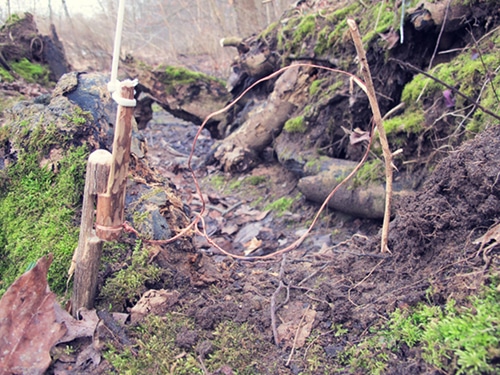
Editor’s note: This is a guest post from Creek Stewart of Willow Haven Outdoor.
I practice and learn survival skills not because I need them on a daily basis, but rather for the one day when I must use them to stay alive. Survival is the intersection between knowledge and necessity. The outcome in a survival scenario can be dramatically influenced by practicing survival skills before you need them. One such skill that requires thoughtful practice is How to Build a Small Game Survival Snare. A primitive make-shift snare can be used to trap and kill a variety of animals for food in a survival situation. This basic concept can also be modified and used as a “man-trap” or “perimeter alarm”–both of which are commonly deployed in guerrilla warfare.
While constructing a survival snare is fairly simple, it is often oversimplified with vague instructions and limited photos. By the time you finish reading this article you will know the who, what, why, when, where, and how of the simplest and most efficient survival snare known to man. If your knowledge ever crosses paths with necessity, this may prove useful.
The Why
For short term survival (1-7 days), food is not a critical priority. Shelter, water, fire, and signaling are typically more immediate concerns. At some point, though, you must put calories on the human furnace or suffer the debilitating consequences of starvation.
To my knowledge there isn’t one single primitive culture, tribe, or people where meat is/was not a critical component of their diet. Modern equipment, farming, transportation, food processing, supplements, and complex supply chains give us the option not to eat meat if we choose. Remove these luxuries for an extended period of time and the calories from meat once again become necessary for survival. It would be extremely difficult, if not impossible, to source enough calories in a primitive survival scenario by gathering wild plant edibles alone–especially in cold weather climates or seasons.
Time and energy conservation are both very important factors to consider in any survival situation. This is precisely why snares are such an important survival tool. Once constructed and set, a snare will allow you to focus on other survival priorities. And, it will keep working even while you are sleeping. With 10 snares you can be hunting in 10 different locations at the same time while expending ZERO energy. You become a one man hunting party. Snares are a survivor’s secret weapon. Not only are snares incredibly reliable and effective, they also require very few resources to build–in materials, energy, and time.
The Who
Before you even think about spending time and energy on building and setting a snare, you must first determine whom (or in this case which animal) your snare is targeting. For survival purposes, small game represents your best chance of success. While the snare design I will show you can be scaled up to catch animals as large as deer, it is more practical to target small game animals such as rabbit, squirrel, and ground dwelling fowl such as quail or grouse. This snare can also be modified to fish for you as well. Not only are smaller game animals easier to catch and field dress, but you can set numerous small game snares with the same time and material resources it would cost you to set one larger snare. Setting snares is a numbers game. The more snares you set, the greater your odds of success.
The When and Where
This snare can be effective in virtually any climate and any environment on any continent. It can be deployed any time of the year and is equally effective day and night. From desert to rain forest, I can’t think of a place where you can’t use some version of it to catch small game.
With that said, placing random snares throughout the woods is foolish and a waste of time and energy. Though they can be baited to draw in animals, snares are most effective when strategically placed in-line with existing small game trails. As you will see in the HOW section of this article, the heart of this snare is a noose which should be positioned across a frequently traveled small game path or shelter entrance such as a den or burrow.
To be successful, you must read the forest or terrain in which you find yourself. You must look for signs of small game traffic and activity. These signs include scat (droppings), tracks, rubs, scratches, signs of feeding, shelter or burrow entrances, food and water sources, and well-traveled game trails.
I took a walk in the forest here at Willow Haven Outdoor and snapped a few photos of some telltale animal signs that should catch the eye of a passing survivor. See if you can identify the small game activity in these photos below:
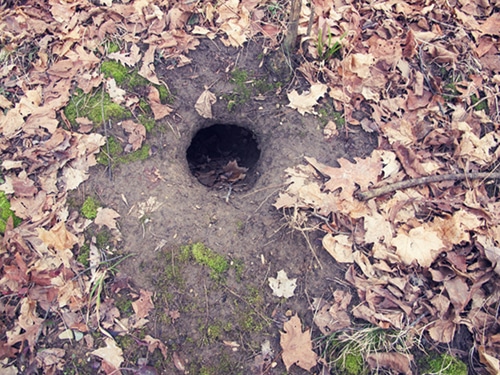
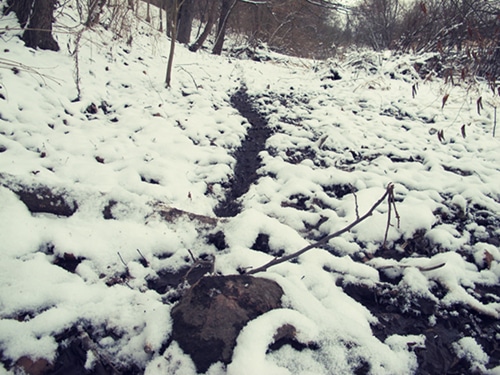
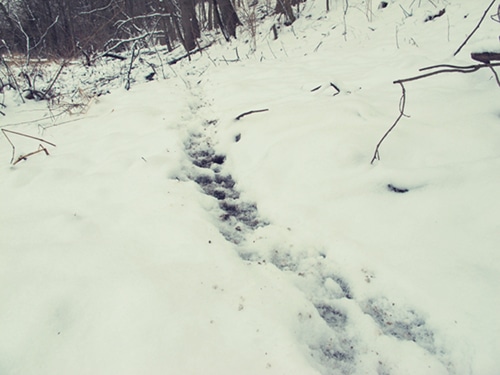
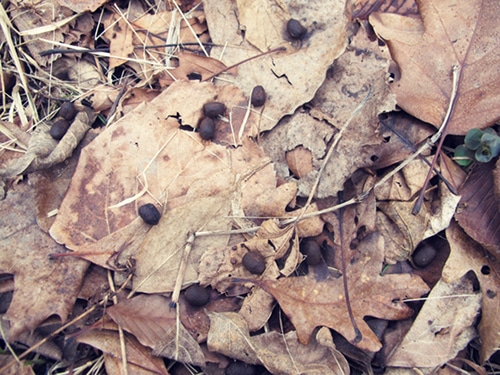
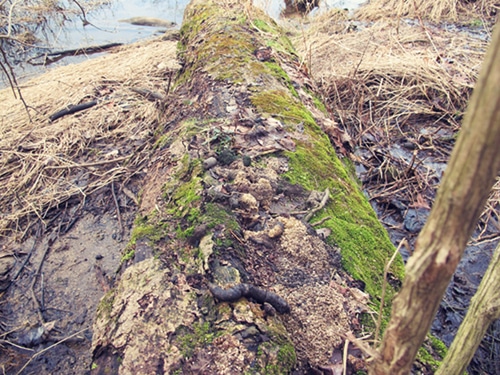
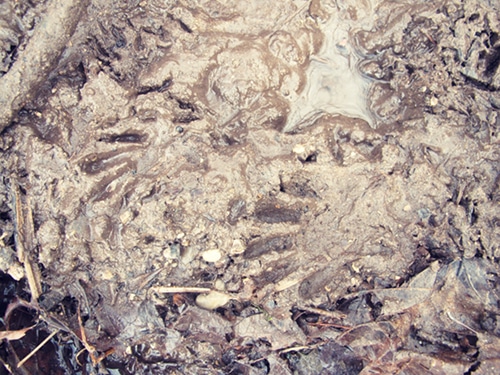
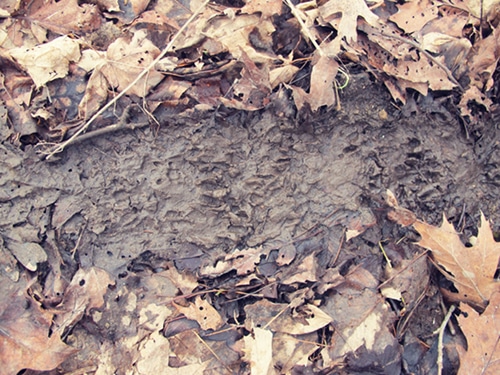
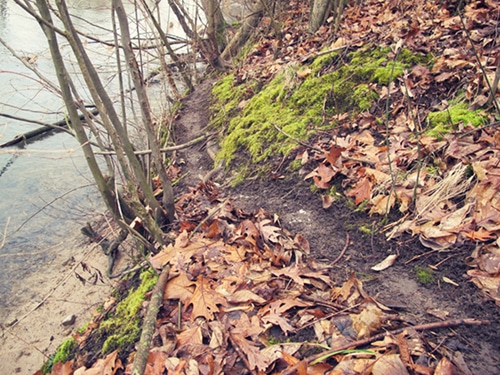
The best place for the snare I detail in the next section is across a well-traveled small game path. These paths, called “runs,” typically lead from the nest, shelter, or den to water and food sources. Animals are the ultimate survivors and also live by the survival code of energy conservation. Consequently, several animals may travel the same trail or path on a regular basis. Animals travel the path of least resistance and strategically placed snares along this path can be very effective.
Finally…The What and the How
There are literally hundreds of different snare sets and designs–some of which are overly complex. If you only learn one snare design in your life, it should be what I call the Trigger Spring Snare. I wish I could take credit for the design, but it dates back to the beginning of mankind and versions of it have been used by primitive people in all parts of the world. It has been time-tested, field-tested and survival-tested. It is my #1 GO-TO Survival Snare set.
The Trigger Spring Snare consists of 4 components which can be readily sourced in nearly any survival situation. These components are:
- The Noose (made from some kind of cordage–preferably wire)
- The 2 Part Trigger (carved from wood)
- The Leader Line (also made from some kind of cordage)
- The Engine (typically a bent over sapling)
The Noose
The noose does exactly what you think–it nooses the animal. The most effective noose material is wire. There are many different types of wire that will work. The wire must be flexible. It cannot be too thick or brittle. When set in the shape of a noose (shown later), it must tighten easily and quickly when pulled upon. Some examples are:
- Twisted copper strands from the inside of an everyday lamp or small appliance power cord
- Picture hanging wire
- Stripped wire from car or vehicle electrical systems
- Craft wire
- Headphone wire
- Wire from a spiral bound note pad
- An uncoiled spring (such as in a ballpoint click pen)
- Wire reinforced bras
- Wire from inside electronics such as toys, phones, and radios
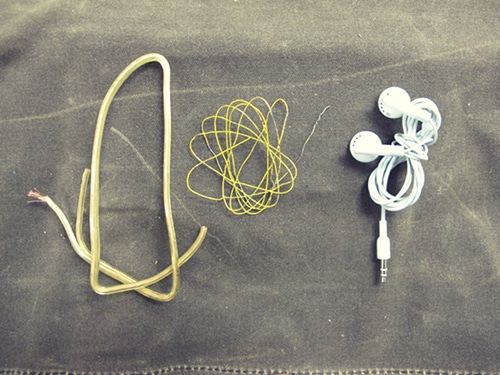
If wire is unavailable, some kind of string or cord will have to do. It must be strong enough to hold a 5-8 lb animal. If it snaps under the force of a couple jerks between your fists then it probably won’t work well.

Here are several alternative cordage ideas:
- The inner strands from 550 Parachute Cord
- Shoe strings
- Dental floss
- Fishing line
- Unwoven webbing
- Strong stitching material such as what is used to sew together leather and outdoor goods such as purses, wallets, cell phone cases, belts, jackets, and backpacks
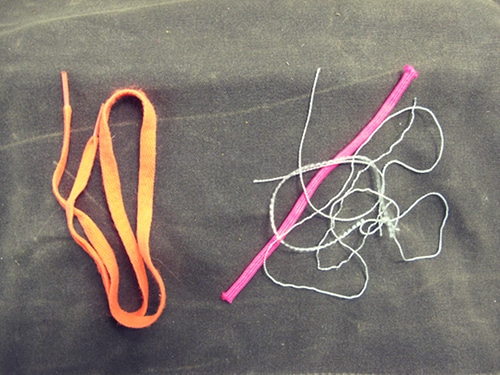
If no modern wire or cordage is available, there are many natural plants and tree bark fibers that can be fashioned into suitable cordage. Several excellent cordage plants/trees are:
- Milkweed
- Dogbane
- Stinging nettle
- Many inner tree barks such as cedar and elm
- Palm
- Cattail
Below is a photo of several cords made from reverse wrapping plant and tree bark fibers. Remember, primitive cultures used this snare for hundreds of years with no modern wire or rope. It takes more time and knowledge but is certainly possible.
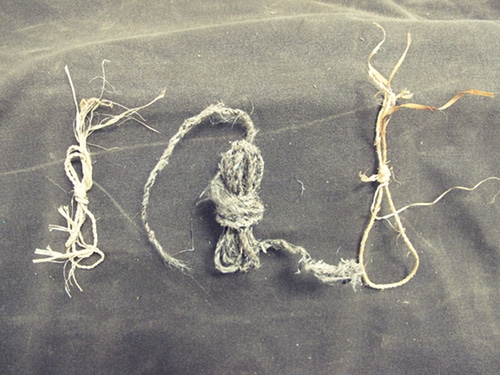
The average length of your noose cord needs to be 18-24 inches for most small game animals. To construct your noose you need to make a small loop in one end about the diameter of a pencil. With wire you can simple make the loop and twist the wire back on itself several times.
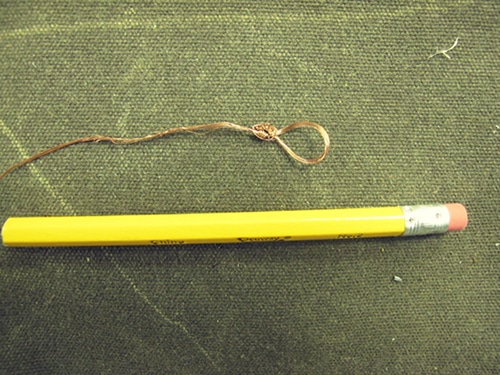
With string, simply fold the end back onto itself and tie an overhand knot to secure the loop.
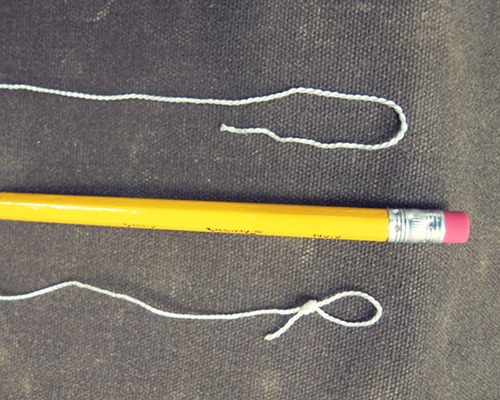
Then, run the other end of the cord/wire through the loop to create your noose. The tag end is then tied to your trigger as is detailed in the next section.
The Trigger and Leader Line
The trigger consists of 2 parts: the HOOK and the BASE. As you can see in the diagram below, the LEADER LINE is tied to the top of the HOOK and the NOOSE is tied to the bottom of the HOOK. The ENGINE (typically a bent over sapling) provides tension to the HOOK which is secured under the BASE–until an animal disengages it by pulling on the NOOSE. The LEADER LINE from the HOOK to the ENGINE can be any type of cordage. It needs to be strong enough to withstand the initial “spring jerk” and then the weight of the suspended (and struggling) animal.
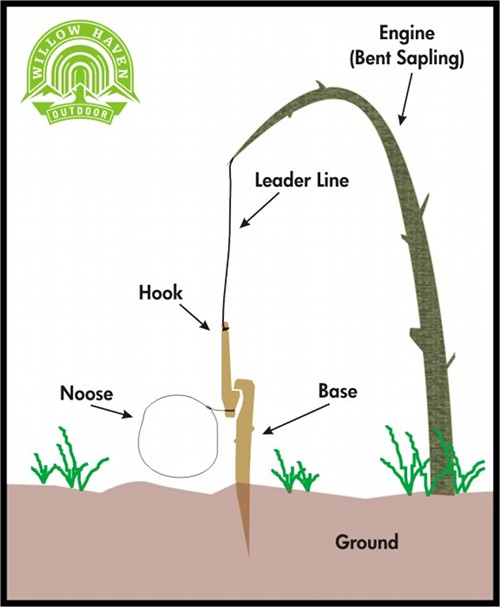
Several Trigger Modifications
When it comes to this style of trigger, don’t limit yourself to one exact model. The same result can be accomplished in many similar ways. You may have to improvise in a survival scenario. It is the principle that is important. Below are several trigger modifications that I worked up to give you a few ideas.
CARVED TRIGGER
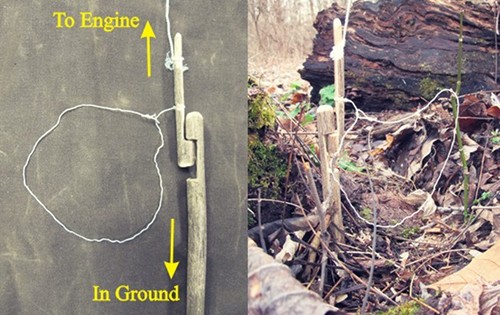
This trigger style is simply carved from 2 hard wood sticks. Notice the BASE of the trigger system that is staked into the ground. The noose in the photo above is made from the inner strands of 550 paracord. Below is another photo of a carved trigger snare. This noose is made from the copper wires from inside an old lamp cord which makes an ideal noose material. Notice how I’ve used little twigs to hold my noose in place. This can be helpful to keep your noose exactly where you want it.
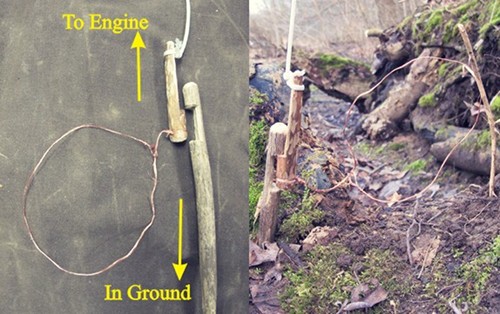
PRIMITIVE “Y†STICK TRIGGER
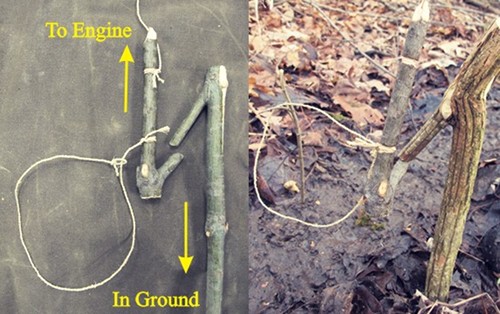
This trigger requires very little carving– simply find 2 sticks that branch how you need them and let nature provide your trigger system. The noose in this photo is made from the fibers of a raffia palm tree. This BASE is also staked into the ground.
PEG STYLE TRIGGER
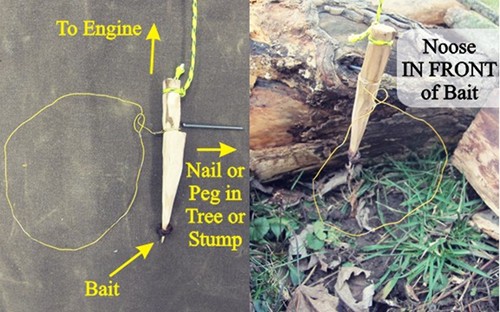
Rather than having a BASE that is staked in the ground, the HOOK of this trigger system is secured on a peg or nail that you can place in a nearby log, stump, or tree. I’ve even created triggers that have hooked onto nearby rock ledges. This photo also features a “baited trigger.” I have sharpened the bottom of the hook and stuck on a piece of bait (raisin) to lure an animal through the noose. As soon as the bait is tampered with, the HOOK disengages. Make sure the animal must put its head through the noose to access a baited trigger.
Fishing Modification
This same trigger snare principle can be used with a hook and line for fishing as well. Instead of using a noose, attach your fishing line to the bottom of the HOOK TRIGGER. When a fish pulls your line and disengages the trigger, the ENGINE will pull and set the hook in the fish’s mouth. Make sure your TRIGGER HOOK is just barely set so that the slightest tug from a nibbling fish engages the ENGINE. See the diagram below:
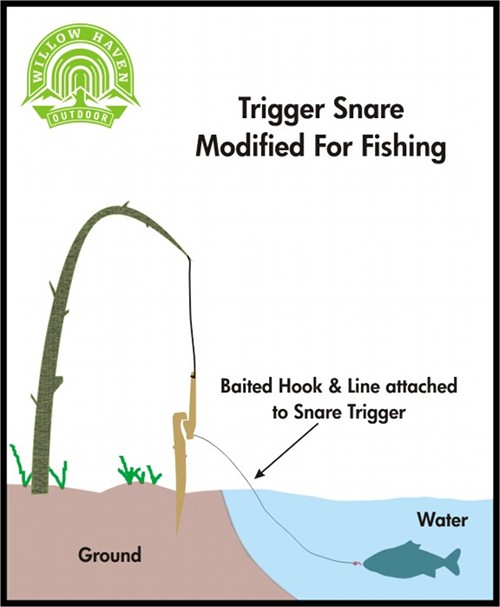
The Engine
Every environment is different and unique. There may not be a sapling to bend over along a game trail. Or, you may be in the middle of a prairie or field where there are no trees at all. If so, you must improvise. There are many ways to do this. One way is to simply cut down a green sapling or branch from another area and stake it in the ground to use as an ENGINE. Your LEADER LINE can also be weighted and run over a branch or make-shift tripod to serve the same purpose. In the photo below I’ve weighted the LEADER LINE with a 10 pound rock that applies tension to the TRIGGER. I used the bark from a root as the LEADER LINE and a NOOSE made from braided cattail leaves–this is a 100% primitive snare set.
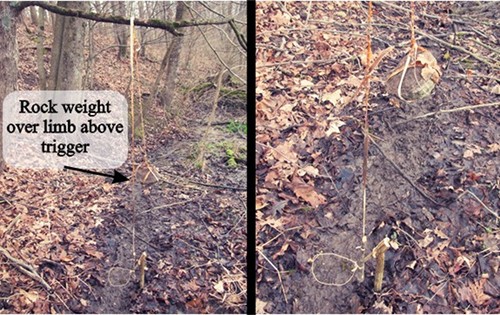
In the set below, I used a similar principle except I erected a make-shift tripod to serve as an anchor point for the LEADER LINE. Here, the LEADER LINE is a high visibility 550 Paracord.
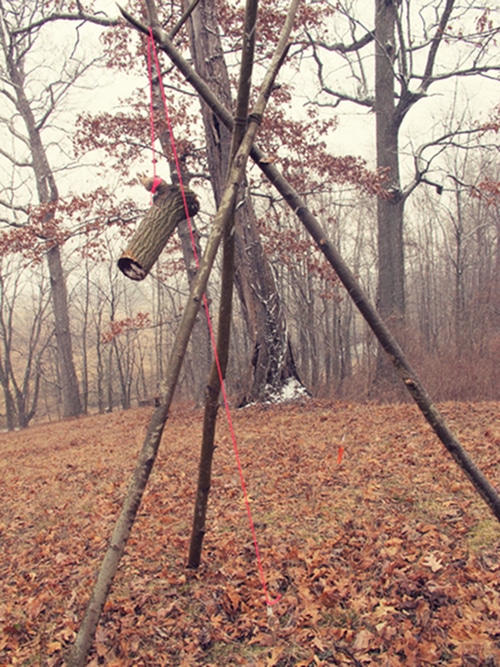
Your ENGINE (whether a sapling, branch, or weighted system) should be powerful enough to suspend a small game animal in the air. This helps to ensure a faster and more humane kill and also keeps your catch away from other predators who would certainly be very interested in a free meal. If in doubt, you can test your snare ENGINE by using a 6-8 pound rock or log.
A NOTE ABOUT TIME AND ENERGY CONSERVATION:
The NOOSE from this snare system can be an incredibly effective snare by itself–without a TRIGGER or ENGINE. By securing the tag end of the NOOSE to a stake or tree and placing it across a burrow/nest entrance or a very well-traveled small game run, a trigger system may not even be necessary. This is a very popular method for snaring rabbits. It doesn’t get easier than this. Be prepared, though, for a live animal once you return in many cases. See the diagram below.
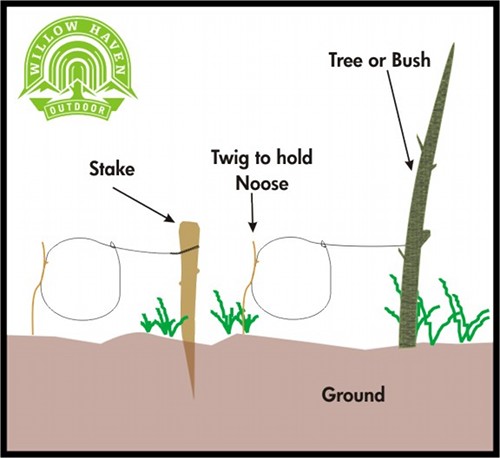
Directing the Traffic Flow
As I mentioned earlier, animals will typically follow the path of least resistance to conserve energy. Use this to your advantage by arranging sticks, logs, dirt, rocks, or other objects in such a way that funnels the animal into your snare NOOSE.
Try not to disturb the area too much if possible. The more natural you leave it the better. Animals survive on INSTINCT and will react if something seems out of place. The forest is their home and they know it by heart. Leave as little trace of your activity as possible.
Conclusion
I’ll end this article with a list of Survival Snaring Guidelines that I follow and for you to consider.
- Survival snares are for survival situations. Primitive improvised snares are otherwise illegal.
- The more snares you set, the greater your chances of success.
- If moving from an area, disable all snares you’ve set.
- Check your snare sets several times each day if possible–especially in warm weather. Your catch can spoil or be scavenged by other predators. And, if you have a live animal, you don’t want it to suffer longer than it has to.
- If you kill it, eat it. A diseased animal is the exception.
- Remains from previously snared animals make excellent bait for other snares–especially entrails.
- Meat is not the only survival resource that can be gained from snaring an animal. The hide can be used. Most animals have enough brains to brain-tan their own hide. Bones can be used as tools, hooks, and spear points. Intestines, sinew, and rawhide can be used for lashings and cordage. Use as much of the animal as possible. It has given its life for you.
I keep a handful of ready-made wire snares in my survival kit and Bug Out Bag. They are extremely lightweight and take up very little space. And, wire is a multifunctional kit item that can be used for a variety of tasks.
The key to survival is not about mastering a single survival skill, but rather about being well-rounded in a variety of skills that can help provide you with basic needs–and FOOD is certainly one of these in an extended survival scenario. Energy conservation is very important and using snares to secure food is an intelligent use of time and resources. I hope you’ve taken away something useful from this post.
Remember, it’s not IF but WHEN,
Creek
____________________
Creek Stewart is a Senior Instructor at the Willow Haven Outdoor School for Survival, Preparedness & Bushcraft. Creek’s passion is teaching, sharing, and preserving outdoor living and survival skills. Creek is also the author of the book Build the Perfect Bug Out Bag: Your 72-Hour Disaster Survival Kit. For more information, visit Willowhaven Outdoor.


